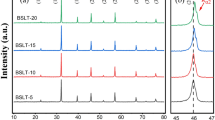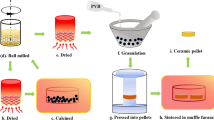Abstract
Study on dielectric relaxation of various ferroelectric perovskites in their paraelectric phase had been reported recently. A common accepted idea is oxygen vacancy should be responsible for the observed nonferroelectric dielectric relaxation. The present authors had observed low-frequency dielectric relaxations in the paraelectric phase of Ba(Ti,Sn)O3 ceramics. In the temperature range of 100 to 450 °C, peaks of loss tangent shift to higher temperature for higher frequency. The results of redox treatment excluded the possibility of defect polarization of oxygen vacancy. It is argued that hopping of localized hole contribute to the dielectric relaxation and to the electronic conducting characteristics.
Similar content being viewed by others
Avoid common mistakes on your manuscript.
Introduction
Dielectric relaxation behavior of various ferroelectric perovskites in their paraelectric phases had been reported by several authors [1–4]. The observed low-frequency dielectric relaxations seem to be of Debye type, composition-insensitive, and ferroelectricity-independent.
Stumpe et al. [1] ascribed the observed dielectric relaxation of SrTiO3 and BaTiO3 to interface polarization of a surface layer. Following Coelho’s [5] polarization model of space distributed charge carriers, Bidault et al. [2] developed a space charge model to describe the dielectric behavior in titanium-containing perovskites with considerable charge carrier concentration, which is most probably oxygen vacancy. Chen et al. [3] explained the dielectric relaxation observed in Bi-doped SrTiO3 in a temperature range of 500 to 800K by short-range hopping of oxygen vacancies, and the subsequent experimental results of oxidation supported his viewpoint. Kang and Choi [4] found nonferroelectric relaxation peaks in lanthanum-doped lead titanate.
The present authors had observed similar low-frequency (102 to 105 Hz) dielectric relaxation in paraelectric phase of barium stannate titanate, Ba(Ti,Sn)O3 (BTS), ceramics. In the temperature range of 450 to 750K, peaks of loss tangent shift to higher temperature for higher frequency. However, the subsequent redox experiments found different results with that of the reports of Bidault et al. [2] and Chen et al. [3].
Experiment
BTS is a solid solution system of barium titanate and barium stannate. Ceramics samples of BTS10 [Ba(Ti0.90Sn0.10)O3], BTS20 [Ba(Ti0.80Sn0.20)O3], and BTS30 [Ba(Ti0.70Sn0.30)O3] were prepared by solid-state reaction. The dielectric peaks (1 kHz) corresponding to ferroelectric to paraelectric phase transition of these samples locate at 50, −30, and around −110 °C, respectively. Sample geometry is about 10 mm in diameter and 1 mm in thickness. The temperature-dependence of dielectric constant was measured via a computer-controlled system, including a high-precision LCR meter (HP4284A, Hewllet Packard) and a homemade high-temperature oven with its temperature range from room temperature to 1200 °C.
Results
Dielectric constants and loss tangents with the temperature of BTS samples are shown in Fig. 1. In spite of their different tin content, no significant difference of dielectric properties can be found for the three samples in the range of 100–450 °C. Dielectric constant exhibits peaks or anomalies, and loss tangent exhibits more obvious peaks. These peaks shift to higher temperature for higher frequency.
Temperature location and maximum value of loss tangent peaks of BTS10, BTS20, and BTS30 at different frequencies are listed in Table 1. In Debye’s theory of relaxation, the following equations are valid at the temperature of loss tangent peak.
where ɛ s and ɛ ∞ are static and optic dielectric constants, respectively. The relaxation time t and the corresponding relaxation frequency ω r can be calculated based on these equations. Furthermore, according to Debye’s theory, activation energy E a and relaxation frequency at infinite high temperature ω 0 can be fitted using Eq. 3. The results are listed in the last two columns in Table 1.
where k b is Boltzmann’s constant and T is temperature.
Figure 2 shows the influence of redox treatments of the BTS30 sample. After 800 °C/2 h of reductive treatment in N2 atmosphere, the dielectric anomaly decreased dramatically compared to that of the original state. The subsequent 800 °C/2 h of annealing in air almost recovered the amplitude of anomaly. Similar phenomena had been observed for all the three BTS samples.
Figure 3 shows the dielectric properties of BTS30 sample with ohmic electrodes. The high temperature relaxation is similar to that of samples with nonohmic electrodes shown in Fig. 1(c).
Figure 4 shows dielectric frequency spectrum of BTS30 at a temperature range of 150 to 350 °C. At 200 °C, the dielectric absorption decreases linearly in double logarithm coordinates with a slope of −0.95. The slope remains almost unchanged for higher temperatures. At low frequency, dielectric absorptions slightly depart from linearity and dielectric constants show similar variations. At high frequency, dielectric constants are almost frequency-independent. The critical frequency increases with increasing temperature.
Figure 5 shows alternative current (AC) conductivity of BTS30 sample. It can be found that reductive treatment decrease AC conductivity of the sample, and annealing in air raise the conductivity to its original values. In addition, three temperature regions can be found in Fig. 5. In region A, frequency dispersion of nominal conductivity is attributed to dielectric loss of dipolar polarization. In region B, pure conductive behavior can be observed with an activation energy of 0.74 eV, which is close to the activation energy (0.79 eV) of dielectric relaxation of BTS30 listed in Table 1. In region C, another frequency dispersion region was observed corresponding to dielectric constant anomaly.
Discussion
Similar to the present dielectric relaxation in BTS10, BTS20, and BTS30, Bidault et al. [2] and Chen et al. [3] had observed high-temperature dielectric relaxation in various materials. They ascribed the relaxation behavior to hopping of oxygen vacancy at high temperature based on results of redox experiments. It seems that oxygen vacancy should most probably be responsible for the present dielectric relaxation. However, as shown in Fig. 2, the present authors found different results, i.e., reductive treatment decrease the amplitude of dielectric anomaly and oxidative annealing recover the anomaly. This is contradictory to the viewpoint of oxygen vacancy hopping, because whatever happens the concentration of oxygen vacancy will increase at lower oxygen partial pressure. This leads to enhanced dielectric anomaly. Smith [6] had reported a study on equilibrium conductivity of undoped barium titanate in his recent book. He found that the conductive behavior of nominal stoichiometric barium titanate is similar to that of acceptor-doped composition, and believed it is caused by the acceptor-dominated impurity. He proposed that the primary defect contribute to the conduction of a hole, which is formed via oxidation of extrinsic oxygen vacancy.
From this equation, we can find that concentration of hole increases with oxygen partial pressure and vice versa. This enlightened us to pay attention on dielectric contribution of hole.
In ordinary viewpoint, hole is a charge carrier only. How does it contribute to both conductivity and dielectric constant? One possible explanation is related to interfacial polarization. Bidault et al. [2] had observed dielectric relaxations in both single crystal and ceramics. This excludes the possibility of space charge interfacial polarization near crystal boundary. Bidault et al. [2] and Coelho [5] supposed that the electrodes are blocked, i.e., it is not transparent to charge carrier. The interfacial accumulation of charge carrier contributes to a large dielectric constant. The reason of blocked electrode is most probably caused by a Schottky barrier. The present author intended to use ohmic electrodes to eliminate the effect of interfacial barrier. The dielectric relaxations still hold as shown in Fig. 3. This result also rules out the space charge polarization in electrode interface.
Another explanation is connected with hopping charge carrier. This process is related to hopping of weakly bounded charge carrier around its equilibrium position. The frequency spectrum shown in Fig. 4 is far way from Debye relaxation. It is characteristic of a mixed contribution of dipolar polarization and hopping charge carrier mechanism, which is characterized by low-frequency dispersion. Jonscher [7] had systematically studied the dielectric behavior of hopping charge carrier. Compared to free charge carrier, these electronic carriers are localized. By an action of an external field, the carrier may be displaced by means of hopping transitions between localized levels, not involving excitations into free bands. This movement shows dielectric characteristics, as well as conducting characteristics from its extended hopping over many sites. Hopping of charge carrier is a time-consuming procedure. When the period of external field is comparable with the characteristic time of hopping at certain temperature, the dielectric response exhibits an anomaly.
In the present case, it is argued that the hopping of localized hole contributes to both conducting and dielectric properties. In region B of Fig. 5, the AC conductivity is roughly a straight line, which indicates single hopping conducting mechanism of a hole. In region C, the frequency dispersion corresponds to hopping relaxation of a hole.
Conclusion
Low-frequency dielectric relaxation was observed in BTS ceramics in the temperature range of 100 to 450 °C. The results of redox treatment excluded the possibility of defective polarization of oxygen vacancy. It is argued that hopping of localized hole contribute to the dielectric relaxation and to the electronic conducting characteristics.
References
R. Stumpe, D. Wagner, D. Bauerle, Phys. Status Solidi A Appl. Res. 75, 143 (1983)
O. Bidault, P. Goux, M. kchikech, M. Belkaoumi, M. Maglione, Phys. Rev. B 49, 7868 (1994)
A. Chen, Y. Zhi, L.E. Cross, Phys. Rev. B 62, 228 (2000)
B.S. Kang, S.K. Choi, Appl. Phys. Lett. 80, 103 (2002)
R. Coelho, Physics of Dielectrics (Elsevier, New York, 1978)
D.M. Smyth, The Defect Chemistry of Metal Oxides (Oxford University Press, New York, 2000)
A.K. Jonscher, Dielectric Relaxation in Solids (Chelsea Dielectric Press, London, 1983)
Acknowledgements
The author (XYW) thanks Mr. Lei Zhang for technical assistance in the redox experiment. This work is supported by the Ministry of Sciences and Technology of China through 973-project under grant no. 2002CB613304; by the National Natural Science Foundation of China (project 50402015); and Key Science and Technology Research Project from the National Ministry of Education (grant no. 03155).
Author information
Authors and Affiliations
Corresponding author
Rights and permissions
About this article
Cite this article
Wei, X., Wan, X. & Yao, X. Dielectric relaxation in paraelectric phase of Ba(Ti,Sn)O3 ceramics. J Electroceram 21, 226–229 (2008). https://doi.org/10.1007/s10832-007-9099-1
Published:
Issue Date:
DOI: https://doi.org/10.1007/s10832-007-9099-1









